Corn snake
| Corn snake | |
|---|---|
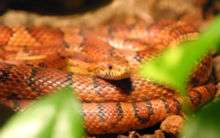 | |
| Scientific classification | |
| Kingdom: | Animalia |
| Phylum: | Chordata |
| Subphylum: | Vertebrata |
| Class: | Reptilia |
| Subclass: | Lepidosauria |
| Order: | Squamata |
| Suborder: | Serpentes |
| Family: | Colubridae |
| Subfamily: | Colubrinae |
| Tribe: | Lampropeltini |
| Genus: | Pantherophis |
| Species: | P. guttatus |
| Binomial name | |
| Pantherophis guttatus (Linnaeus, 1766) | |
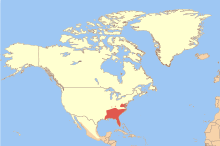 | |
| Synonyms | |
| |
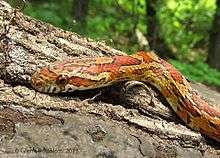
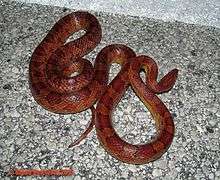
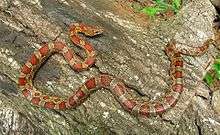
The corn snake (Pantherophis guttatus) is a North American species of rat snake that subdues its small prey by constriction.[4][5] It is found throughout the southeastern and central United States. Their docile nature, reluctance to bite, moderate adult size, attractive pattern, and comparatively simple care make them popular pet snakes. Though superficially resembling the venomous copperhead and often killed as a result of this mistaken identity, corn snakes are harmless and beneficial to humans.[6] Corn snakes lack venom and help control populations of wild rodent pests that damage crops and spread disease.[7]
The corn snake is named for the species' regular presence near grain stores, where it preys on mice and rats that eat harvested corn.[8] The Oxford English Dictionary cites this usage as far back as 1675. Some sources maintain that the corn snake is so-named because the distinctive, nearly-checkered pattern of the snake's belly scales resembles the kernels of variegated corn.[9][10] Regardless of the name's origin, the corn reference can be a useful mnemonic for identifying corn snakes.
Description
Adult corn snakes have a body length of 61–182 centimetres (2.00–5.97 ft).[11] In the wild, they usually live around 6–8 years, but in captivity can live to an age of 23 years or more.[12] They can be distinguished from Copperhead snakes by their brighter colors, slender build and lack of heat-sensing pits.[13]
Taxonomy
Until 2002, the corn snake was considered to have two subspecies: the nominate subspecies (Pantherophis guttatus guttatus) described here and the Great Plains rat snake (Pantherophis guttatus emoryi). The Great Plains rat snake has since been split off as its own species (Pantherophis emoryi), but is still occasionally treated as a subspecies of the corn snake by hobbyists.
It has been suggested that Pantherophis guttatus can be split into three species: Pantherophis guttatus, Pantherophis emoryi (corresponding with the subspecies Pantherophis guttatus emoryi) and Pantherophis slowinskii (occurring in western Louisiana and adjacent Texas).[14]
Pantherophis guttatus was previously placed in the genus Elaphe, but Elaphe was found to be paraphyletic by Utiger et al., leading to placement of this species in the genus Pantherophis.[15] The placement of Pantherophis guttatus and several related species in Pantherophis rather than Elaphe has been confirmed by further phylogenetic studies.[16][17] Many reference materials still use the synonym Elaphe guttata.[18] Molecular data has shown that corn snakes are actually more closely related to king snakes (genus Lampropeltis) than they are to the Old World rat snakes with which they were formerly classified. Corn snakes have even been bred in captivity with California king snakes to produce fertile hybrids known as "Jungle corn snakes".[19]
Natural habitat
Wild corn snakes prefer habitats such as overgrown fields, forest openings, trees, palmetto flatwoods and abandoned or seldom-used buildings and farms, from sea level to as high as 6,000 feet. Typically, these snakes remain on the ground until the age of 4 months old but can ascend trees, cliffs and other elevated surfaces.[20] They can be found in the southeastern United States ranging from New Jersey to the Florida Keys and as far west as Texas.
In colder regions, snakes hibernate during winter. However, in the more temperate climate along the coast they shelter in rock crevices and logs during cold weather, and come out on warm days to soak up the heat of the sun. During cold weather, snakes are less active and therefore hunt less.
Reproduction
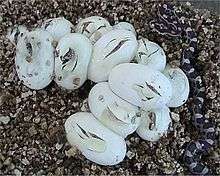
Corn snakes are relatively easy to breed. Although not necessary, they are usually put through a cooling (also known as brumation) period that takes 60–90 days. This is to get them ready for breeding and to tell them that its time to reproduce. Corns brumate at around 10 to 16 °C (50 to 61 °F) in a place where they can not be disturbed and with little sunlight.
Corn snakes usually breed shortly after the winter cooling. The male courts the female primarily with tactile and chemical cues, then everts one of his hemipenes, inserts it into the female, and ejaculates his sperm. If the female is ovulating, the eggs will be fertilized, and she will begin sequestering nutrients into the eggs, then secreting a shell.
Egg-laying occurs slightly more than a month after mating, with 12–24 eggs deposited into a warm, moist, hidden location. Once laid the adult snake abandons the eggs and does not return to them. The eggs are oblong with a leathery, flexible shell. Approximately 10 weeks after laying, the young snakes use a specialized scale called an egg tooth to slice slits in the egg shell, from which they emerge at about 5 inches in length.
Diet and behavior

Like all snakes, corn snakes are carnivorous, and in the wild they eat every few days. While most corn snakes will eat small rodents, such as the White-footed Mouse, they may also eat reptiles or amphibians, or climb trees to find unguarded bird eggs.[21] Behavioral/chemosensory studies with corn snakes suggest that odor cues are of primary importance for prey detection, whereas visual cues are of secondary importance.[22][23]
In captivity
Corn snakes are one of the most popular types of snakes to keep in captivity or as pets. Their size, calm temperament, and ease of care contribute to this popularity. Captive corn snakes tolerate being handled by their owners, even for extended periods.[24] A corn snake's space requirements are low since a 25-gallon vivarium provides enough room for a fully grown snake. Corn snakes enjoy hiding and burrowing, usually accommodated with a loose substrate (such as Aspen wood shavings or newspaper) and one or more hide boxes.[25] Captive corn snakes are generally fed pre-killed or stunned feeder mice, because captive-bred rodents reduce the risk of pathogens or live prey-induced injuries.[26]
Variations
After many generations of selective breeding, domesticated corn snakes are found in a wide variety of different colors and patterns. These result from recombining the dominant and recessive genes that code for proteins involved in chromatophore development, maintenance, or function. New variations, or morphs, become available every year as breeders gain a better understanding of the genetics involved.
Color morphs
- Normal or wildtype corn snakes are orange with black lines around red colored saddle markings going down their back with black and white checkered bellies. Regional diversity is found in wild caught corn snakes, the most popular being the Miami and Okeetee phases. These are the most commonly seen corn snakes.
- Miami Phase (originates in the Florida wildtype) These are usually smaller corn snakes with some specimens having highly contrasting light silver to gray ground color with red or orange saddle markings surrounded in black. Selective breeding has lightened the ground color and darkened the saddle marks. The “Miami” name is now considered an appearance trait
- Okeetee corn snakes. These snakes are characterized by deep red dorsal saddle marks surrounded by very black borders on a bright orange ground color. As with the Miami phase, selective breeding has changed the term “Okeetee” to an appearance rather than a locality. Some on the market originate solely from selectively breeding corn snakes from the Okeetee Hunt Club.
- Candy-cane (selectively bred amelanistic) These are amelanistic corn snakes bred toward the ideal of red or orange saddle marks on a white background. Some were produced using light creamsicle (an amel hybrid from emory rat x corn ) bred with Miami phase corn snakes. Some candy canes will develop orange coloration around the neck region as they mature and many labeled as candycanes later develop significant amounts of yellow or orange in the ground color. The contrast they have as hatchlings often fades with maturity.
- Reverse Okeetee (selectively bred amelanistic) an amelanistic Okeetee corn snake which has the normal black rings around the saddle marks replaced with wide white rings. Ideal specimens are high contrast snakes with light orange to yellow background and dark orange/red saddles. Note: Albino Okeetees are not locale-specific okeetees—they are selectively bred amelanistics
- Fluorescent orange (selectively bred amelanistic) develop white borders around bright red saddle marks as adults on an orange background.
- Sunglow (selectively bred amelanistic) another designer amelanistic corn that lacks the usual white speckling that often appears in most albinos, and selected for exceptionally bright ground color. The orange background surrounds dark orange saddle marks.
- Blood red (selectively bred “Diffused”) corn snakes carry a recessive trait (known as diffused) that eliminates the ventral checkered patterns. These originated from a somewhat unicolor Jacksonville and Gainesville, Florida strain of corn snake. Through selective breeding, an almost solid ground color has been produced. Hatchlings have a visible pattern that can fade as they mature into a solid orange red to ash red colored snake. The earlier bloodreds tended to have large clutches of smaller than average eggs that produce hard to feed offspring, though this is no longer the case.
- Crimson (hypomelanistic + Miami) are very light high contrast snakes with a light background and dark red/orange saddle marks.
- Anerythristic (anerythristic A, sometimes called "black albino") are the complement to amelanism. The inherited recessive mutation of lacking erythrin (red, yellow, and orange) pigments produces a snake that is mostly black, gray and brown. When mature, many type A anerythristic corn snakes develop yellow on their neck regions which is a result of the carotenoids in their diet.
- Charcoal snakes (sometimes known as anerythristic type ‘B’) can lack the yellow color pigment usually found in all corn snakes, They are a more muted contrast compared to Anerythristics.
- Caramel corn snakes are another Rich Zuchowski engineered corn snake. The background is varying shades of yellow to yellow-brown. Dorsal saddle marks vary from caramel yellow to brown, and chocolate brown.
- Lavender corn snakes contain a light pink background with darker purple gray markings. They also have ruby to burgundy colored eyes.
- Cinder corns originated with Upper Keys corns and as such are often built slimmer than most other morphs. They may resemble anerythristics, but with wavy borders around their saddles.
- Kastanie This gene was first discovered in Germany. Kastanies hatch out looking nearly anerythristic but gain some color as they mature, to eventually take on a chestnut coloration.
- Hypomelanistic or Hypos for short carry a recessive trait that reduces the dark pigments causing the reds, whites, and oranges to become more vivid. Their eyes remain dark. These snakes range in appearance between amelanistic corn snakes to normals with greatly reduced melanin.
- Ultra Ultra is a hypomelanistic-like gene that is an allele to the amelanistic gene. Ultra corn snakes have light grey lines in place of black. The Ultra gene is derived from the grey rat snake. All Ultras and Ultramels have some amount of grey rat snake in them.
- Ultramel is an intermediate appearance between ultra and amel which is the result of being heterozygous for ultra and amel at the albino locus.
- Dilute is another melanin-reducing gene in which the snake looks as if it is getting ready to shed.
- Sunkissed is a hypo-like gene which was first found in Kathy Love’s colony.
- Lava is an extreme hypo-like gene which was discovered by Joe Pierce and named by Jeff Mohr. What would normally be black pigment in these is instead a grayish-purple.
Pattern morphs

- Motley a snake with a clear belly and an “inverted” spotting pattern. May also appear as stripes or dashes.
- Stripe this morph also has a clear belly and a striping pattern. Unlike the motley the stripes will not connect, but may sometimes break up and take on a “cubed” appearance. Cubes and spots on a striped corn are the same as the saddle color on a similar normal corn, unlike motley snakes. Stripe is both allelic and recessive to motley, so breeding a striped corn and a (homozygous) motley corn will result in all motley corn snakes, and breeding these (heterozygous) motley corn offspring will result in ¾ motley and ¼ striped corn snakes.
- Diffusion diffuses the patterning on the sides and eliminates the belly pattern. It is one component of the bloodred morph.
- Sunkissed while considered a hypo-like gene, sunkissed also has other effects such as rounded saddles and unusual head patterns.
- Aztec, zigzag and banded are selectively bred multigenetic morphs (that is not dependent on a single gene).
Compound morphs
There are tens of thousands of possible compound morphs. Some of the most popular are listed.
- Snow (Amelanistic + Anerythristic) As hatchlings this color variation is composed of white and pink blotches. These predominantly white snakes tend to have yellow neck and throat regions when mature (due to carotenoid retention in their diet). Light blotches and background colors have subtle shades of beige, ivory, pink, green, or yellow.
- Blizzard (Amelanistic + Charcoal). Blizzards are a totally white snake with red eyes and very little to no visible pattern.
- Ghost (Hypomelanistic + Anerythristic A) These exhibit varying shades of grays and browns on a lighter background. These often create pastel colors in lavenders, pinks, oranges, and tan.
- Phantom These are a combination of Charcoal and Hypomelanistic.
- Pewter (Charcoal + Diffused) are silvery lavender with very little pattern as adults.
- Butter (Amelanistic + Caramel) A two-tone yellow corn snake.
- Amber (Hypomelanistic + Caramel) have amber-colored markings on a light brown background.

- Plasma (Diffused + Lavender) Hatch out in varying shades of grayish-purple.
- Opal (Amelanistic + Lavender) look like blizzard corn snakes once mature with pink to purple highlights.
- Granite (Diffused + Anerythristic) tend to be varying shades of gray as adults, with males often having pink highlights.
- Fire (Amelanistic + Diffused) are an albino version of the diffused morph. These are typically very bright red snakes with very little pattern as adults.
Scale mutations
- Scaleless corn snakes are homozygous for a recessive mutation of the gene responsible for scale development. While not completely scaleless above, some do have less scales than others. However, all of them possess ventral (belly) scales. They can also be produced with any of the aforementioned color morphs. The first scaleless corns originated from the cross of another North American ratsnake species to a corn snake and are therefore technically hybrids. Scaleless mutants of many other snake species have also been documented in the wild.
Hybrids
Hybrids between corn snakes and any other snakes is very common within captivity and rarely occurs in the wild. Hybrids within the genera Pantherophis, Lampropeltis, or Pituophis so far have been proven to be completely fertile. There are many different corn snake hybrids bred in captivity. A few common examples include:
- Jungle corn snakes are hybrids using the corn snake and California Kingsnake (Lampropeltis getula californiae). These show extreme pattern variations taking markings from both parents. Although they are hybrids of different genera, they are not sterile.
- Tri Color Jungle corn snakes are a hybrid involving Querétaro Kingsnake and corn snake parents. The color is similar to that of an Amelanistic corn snake.
- Creamsicle corn snake is a hybrid involving an albino corn snake and an Emory's Rat snake (Pantherophis emoryi). The first generation hybrids are known as "rootbeers". Breeding these back to each other can produce creamsicles, which are much more yellow-orange than the typical amel corn.
- Turbo corn snakes are hybrids between a corn snake and any Pituophis species.
- Corn snakes hybridized with milk snakes go by a variety of names, depending on the subspecies of milk snake it is. For example, a Honduran Milk Snake × Corn snake is called a Cornduran, a Sinaloan Milk Snake × Corn snake is called a Sinacorn, a Pueblan Milk Snake × Corn Snake is called a puebla corn.
- Brook Korn is a hybrid between the Brook's king snake and a corn snake. Like the jungle corn, the hybrids show extreme pattern variations.
When hybrids of corn snakes are found in the wild they are usually hybridized with other Pantherophis species whose ranges overlap with corn snakes.
References
- ↑ Hammerson, G.A. (2007). "Pantheropis guttatus". IUCN Red List of Threatened Species. Version 2015.3. International Union for Conservation of Nature. Retrieved 22 September 2015.
- ↑ Stejneger L, Barbour T. 1917. A Check List of North American Amphibians and Reptiles. Cambridge, Massachusetts: Harvard University Press. iv + 125 pp. (Elaphe guttata, p. 82).
- ↑ "Pantheropis guttatus". The Reptile Database.
- ↑ Crother, B. I. (2012). "Scientific and standard English names of amphibians and reptiles of North America north of Mexico, with comments regarding confidence in our understanding" (PDF). Society for the Study of Amphibians and Reptiles Herpetological Circular. 39: 1–68.
- ↑ Bealor, M.T. and Saviola, A.J., 2007. Behavioural complexity and prey-handling ability in snakes: gauging the benefits of constriction. Behaviour, 144(8), pp.907-929. http://dx.doi.org/10.1163/156853907781492690
- ↑ "Corn Snake".
- ↑ "Did Someone Say Snakes?".
- ↑ "FLMNH - Eastern Corn Snake (Pantherophis guttatus)".
- ↑ PetCo Corn Snake Care Sheet
- ↑ Smithsonian National Zoo Corn Snake Fact Sheet
- ↑ "Corn Snake Fact sheet". Smithsonian National Zoological Park.
- ↑ Slavens, Frank; Slavens, Kate. "Elaphe guttata guttata".
- ↑ "Reptiles and Amphibians of Virginia". Virginia Herpetological Society.
- ↑ Burbrink, F. T., 2002. Phylogeographic analysis of the corn snake (Elaphe guttata) complex as inferred from maximum likelihood and Bayesian analyses. Molecular Phylogenetics and Evolution 25: 465-476.
- ↑ Utiger, U., N. Helfenberger, B. Schätti, C. Schmidt, M. Ruf, and V. Ziswiler, 2002. Molecular Systematics and Phylogeny of Old and New World ratsnakes, Elaphe Auct., and related genera (Reptilia, Squamata, Colubridae). Russian Journal of Herpetology 9(2): 105-124.
- ↑ Burbrink, F. T. and R. Lawson, 2007. How and when did Old World rattle snakes disperse into the New World? Molecular Phylogenetics and Evolution 43: 173-189.
- ↑ Pyron, R. A. and F. T. Burbrink, 2009. Neogene diversification and taxonomic stability in the snake tribe Lampropeltini (Serpentes: Colubridae) Molecular Phylogenetics and Evolution 52: 524-529.
- ↑ Bartlett, Patricia; Bartlett, R. D. (2006-05-26), Corn Snakes and Other Rat Snakes, Complete Pet Owner's Manual (2nd ed.), Hauppauge NY: Barron's Educational Series, ISBN 978-0-7641-3407-4
- ↑ http://banereptiles.weebly.com/jungle-corn-snakes.html
- ↑ Peterson Field Guide - Western Reptiles and Amphibians - 3rd Edition
- ↑ "ADW: Pantherophis guttatus: INFORMATION". University of Michigan Museum of Zoology.
- ↑ Saviola, A.J., McKenzie, V.J. and Chiszar, D., 2012. Chemosensory responses to chemical and visual stimuli in five species of colubrid snakes. Acta Herpetologica, 7(1), pp.91-103. http://dx.doi.org/10.13128/Acta_Herpetol-9491
- ↑ Worthington-Hill, J.O., Yarnell, R.W. and Gentle, L.K., 2014. Eliciting a predatory response in the eastern corn snake (Pantherophis guttatus) using live and inanimate sensory stimuli: implications for managing invasive populations. International Journal of Pest Management, 60(3), pp.180-186. http://dx.doi.org/10.1080/09670874.2014.953230
- ↑ "The Corn Snake.co.uk".
- ↑ "The Corn Snake.co.uk - Care Sheet".
- ↑ "Corn Snake Care Sheet". South Mountain Reptiles.
External links
| Wikispecies has information related to: Pantherophis guttatus |
| Wikimedia Commons has media related to Pantherophis guttatus. |
| Wikimedia Commons has media related to Elaphe guttata. |
- Feeding Corn Snake Video
- Ians Vivarium Guide to Cornsnake Morphs
- Thecornsnake.co.uk
- herpFocus - video female laying egg.
- Comprehensive Corn Snake care information
- American Cornsnake Registry
- The Cornsnake Morph Guide(R) - identification and genetic guide for collectors and breeders
- Corn snake care sheet
- Ians Vivarium :: Guide to Cornsnake Morphs
- Corn snake genetics calculator - Genetics predication and calculations
- Scientific and Standard English Names of Amphibians and Reptiles of North America North of Mexico, With Comments Regarding Confidence In Our Understanding. Edition 6.1
- Stargazing Information Sheet
- "Pantherophis guttatus". Retrieved 2012-01-12.
